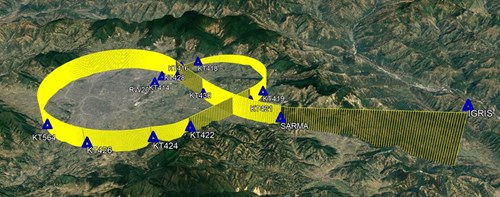Kathmandu airport implements new RNP AR procedures designed by NAVBLUE, for enhanced efficiency and reduced risks in a challenging environment
Improved airport accessibility for enhanced safety and fly-ability
The Civil Aviation Authority of Nepal (CAAN) has published an Aeronautical Information Publication
(AIP) amendment for the entry into service of new RNP AR approaches and departures developed
by NAVBLUE for Tribhuvan International Airport (IATA: KTM, ICAO: VNKT), the main airport
serving Kathmandu, surrounded by mountains with a very challenging operating environment.
Required Navigation Performance with Authorization Required (RNP AR), a Performance Based
Navigation (PBN) navigation specification, is the ideal solution for this type of airport. RNP AR
allows navigation accuracy down to 0.3NM and below, and performing turns after the final approach point: trajectories can fit better in the obstacle landscape, reducing minimas whilst maintaining safety.

NAVBLUE had already developed RNP AR procedures in 2012 for Runway 02 at Kathmandu
Airport, which includes Radius to Fix (RF) turns in the final segment to allow a curved approach
around the mountains, as opposed to the straight-in VOR approach (VHF omnidirectional range)
usually required to go over a mountain. These RNP AR procedures allow a comfortable glide slope
of 2.8 degree compared to the VOR glide slope of 5.3 degree.
The new RNP AR APCH procedures designed by NAVBLUE in 2021 for Runway 20 at Kathmandu
airport offer an IFR (Instrument Flight Rules) alternative to the current VFR (Visual Flight Rules) /
circling approaches. RNP AR departure procedures for both runway ends have also been
developed thanks to NAVBLUE’s unique expertise, providing full benefits to operators equipped
with this capability.
Thanks to these new RNP AR procedures, airlines flying to and from Kathmandu airport will benefit
from:
● Improved airport accessibility thanks to a lower approach minima and less weather
related diversion;
●An approach fully guided in lateral and vertical (using flight director and/or autopilot);
● Improved safety and fly-ability thanks to procedures that can be flown with fully managed guidance;
●An optimised airspace thanks to fully repeatable and predictable trajectories;
●Reduced fuel consumption due to shorter procedures compared to the conventional ones, and optimised vertical paths of the trajectories.
Fabrice HAMEL, CEO of NAVBLUE, said: “NAVBLUE is proud that Kathmandu airport will now
benefit from new RNP AR procedures, which should generate significant benefits for airlines flying
into Nepal. For Runway 20 it even allows for instrument flight procedures where none existed
before. These fully managed RNP AR procedures reduce the risk of unstabilized approaches and
involve fewer go-arounds, bringing operational benefits for the airport, both in terms of efficiency
and safety.”
NAVBLUE has already supported many airlines in their Ops Approvals, Flight Ops Safety
Assessment (FOSA), RAIM predictions and navigation database validation for their RNP AR
operations into Kathmandu, in order to enhance the regularity and safety of their operations in their flights to Kathmandu.
IndiGo, India’s largest airline, has already chosen NAVBLUE and Airbus’s RNP AR modification to
upgrade some of its latest A320 aircraft and to obtain RNP AR approvals to take advantage of the
new procedures.
Kathmandu is the only international airport in Nepal, connecting the country to over 40 destinations in 17 countries, and a hub for two international airlines, the flag carrier Nepal Airlines and Himalaya Airlines, along with several other domestic and regional carriers.


.png)




.jpg)

Comments
There are no comments yet for this item
Join the discussion